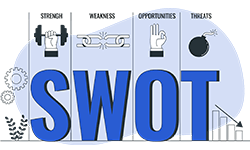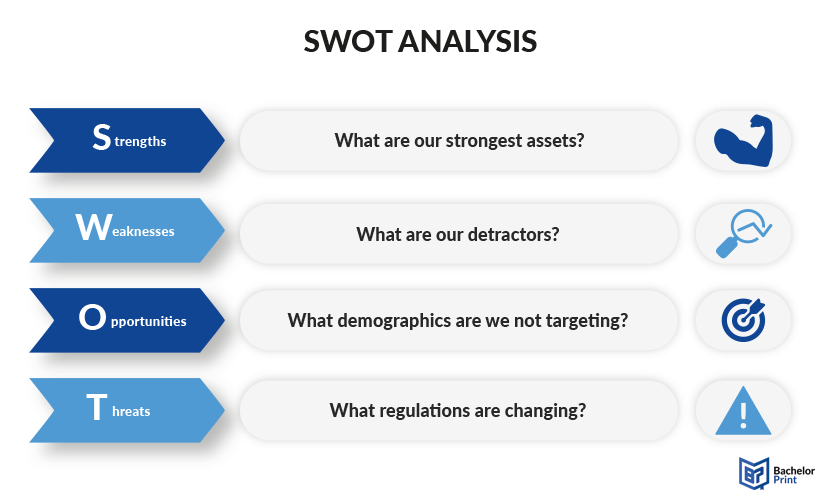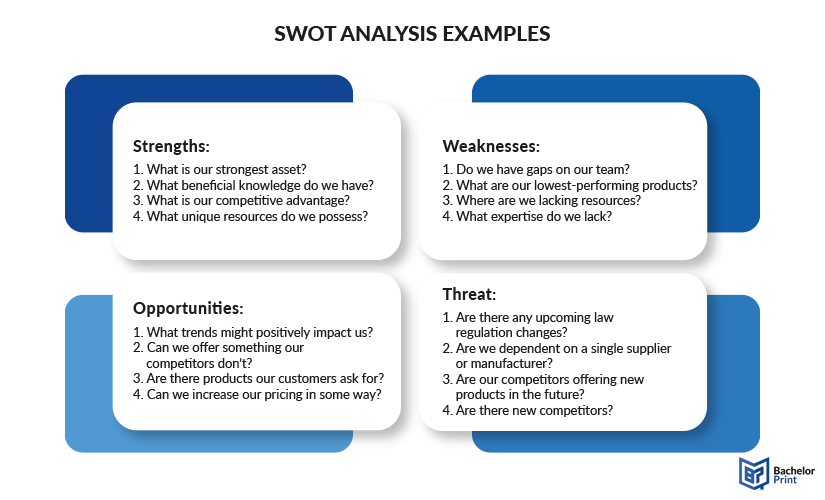
SWOT analysis is a strategic planning methodology used to identify and evaluate the strength, weaknesses, opportunities, and threats related to a business or project. By systematically assessing these four elements of a SWOT analysis, businesses can develop strategies to leverage, strength, address weaknesses, capitalize on opportunities, and mitigate potential threats. This article will dive into its intricacies and additionally offer examples for this method.
Definition: SWOT analysis
SWOT analysis is a comprehensive strategy technique for assessing the performance, competition, risk, and potential of a business or project. This comprehensive framework facilitates a structured approach to assessing internal factors and external forces that can impact the success and sustainability of an endeavor and is a valuable business decision. The acronym of the SWOT analysis stands for Strengths, Weaknesses, Opportunities, and Threats. SWOT has several variations, each offering deeper analysis, such as PEST analysis (Political, Economic, Social, Technological), SOAR analysis (Strengths, Opportunities, Aspirations, Results), and SWAT (Strengths, Weaknesses, Assumptions, Truths).
The 4 steps of SWOT analysis
In this paragraph, we’ll break down the SWOT acronym and explain each step together with examples.


Strengths
These are the internal attributes and resources that an organization or project possesses, which give it a competitive advantage. Internal factors of strengths can be identified by the questions below.
- What are we doing well?
- What is our strongest asset?
- What resources do we have?
The first step can include the following strengths.

Weaknesses
These are the internal factors that may hinder an organization’s or project’s performance. The following questions will help you find every internal weakness:
- What are our detractors?
- What are our lowest-performing products?
- Where are we lacking resources?
Dangerous weaknesses can involve the following points.

Opportunities
These are external factors that the organization or project can exploit to its advantage. When it comes to the external environment, specifically opportunities, you can ask the following questions:
- What market trends are evident?
- What demographics are we not targeting?
- What new technology can we use?
Opportunities might arise from the following.

Threats
Threats are external factors that could jeopardize the organization’s or project’s success. Threats can be identified by asking the following questions:
- How are consumer trends changing?
- What and how are our competitors doing?
- What regulations are changing?
This final step can include the following challenges.
We have created an image for a quick overview with examples.

When to use a SWOT analysis
There are many reasons for using the SWOT analysis. Some are listed as follows.
- For analyzing your current team
- Before launching new projects or ventures
- For new strategy development
- When evaluating a competitor
- During organizational changes (mergers, etc.)
- When facing business problems
How to conduct a SWOT analysis
Conducting a SWOT analysis involves a systematic process of gathering and evaluating information. Here are the steps to successfully conduct this fact-based analysis for your business:
1. Define your objective
A SWOT analysis can encompass many purposes, it is vital to clearly determine what you are analyzing. This could be the entire business, a new project, an upcoming product, or personal development. With a specific objective in mind, the business will have the needed guidance when deciding on the best course of action.
2. Gather information
When it comes to the SWOT analysis, gathering data is fundamental and should include both internal advantages and external factors. A business needs to figure out what information it can access, what limitations it faces, and how reliable external sources are. For this analysis, a diverse combination of personnel should be included for a broad set of perspectives.
3. Conduct brainstorming sessions
Use brainstorming sessions with team members, managers, and relevant stakeholders to generate a comprehensive list of the four components: strengths, weaknesses, opportunities, and threats.
4. Analyze & prioritize
Discuss the impact of each of the four aspects of SWOT analysis you gathered and rank them based on their potential impact and likelihood. By refining your gathered data, you can focus solely on the best ideas or largest risks. For this step, you might want to include upper management to help rank primary factors.
5. Develop strategies
Now that you have listed all four aspects, you should convert your analysis into a strategic plan. Formulate strategies to capitalize on your strengths e.g., by expanding to new markets, develop plans to improve e.g., by hiring additional staff, create action plans to seize opportunities, and develop contingency plans to minimize risks. Regularly review and update your analysis to reflect changes.
in Your Thesis
Pros & cons
The SWOT methodology has its advantages and disadvantages. Below we have listed several for each.
Benefits
Below are five benefits of this methodology.
- Comprehensive overview: The analysis provides a holistic view of internal and external factors affecting a business or project, which enables a thorough understanding of the current situation.
- Simplicity and cost-effective: It is easy to conduct and doesn’t require significant resources or specialized training, making it accessible for small businesses and for bigger organizations.
- Strategic insight: This method helps in identifying strategic opportunities and potential threats, aiding in informed decision-making and strategic planning.
- Versatility: The SWOT analysis can be applied to various scenarios, including business planning, project management, and personal development. This makes it a highly flexible assessment tool.
- Facilitates collaboration: It encourages team involvement and diverse perspectives, which enhance the quality of the analysis through collective input and discussion.
Problems
Below are five problems of this analysis.
- Subjectivity: The results of the SWOT assessment technique can be subjective and influenced by personal biases of the participants, potentially skewing the analysis.
- Lack of prioritization: The analysis does not provide a method to prioritize the identified factors, making it challenging to determine the most critical areas to focus on without additional analysis.
- Static snapshot: It represents a specific moment in time and may not account for rapidly changing environments, requiring regular updates to remain relevant.
- Over-simplification: It may oversimplify complex issues and not provide a profound enough analysis for significant impacts to decisions, necessitating more detailed follow-up studies.
- No implementation guidance: The SWOT methodology identifies issues but does not offer solutions or an action plan to address them, requiring further strategic planning and resource allocation.
FAQs
A SWOT analysis is a strategic business plan used for business operations to identify an organization’s Strengths, Weaknesses, Opportunities, and Threats. For example, a strength might be its strong brand, a weakness could be limited physical resources, an opportunity could be a growing market, and a threat could be new competitors.
SWOT stands for strengths, weaknesses, opportunities, and threats.
Three strengths examples of a SWOT analysis can be:
- Strong brand reputation
- High-quality customer service
- Robust financial position
Five examples of opportunities of a SWOT analysis could be:
- Market expansion
- Technological advancements
- Strategic partnerships
- Entering new geographic markets
- Product diversification